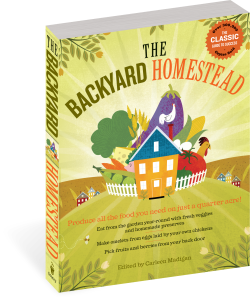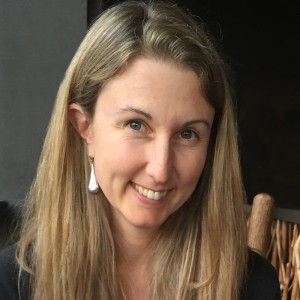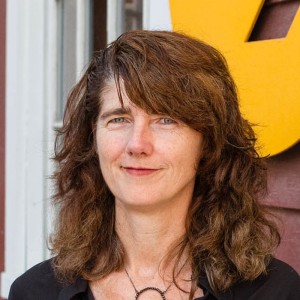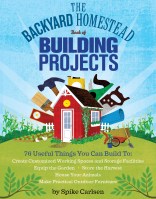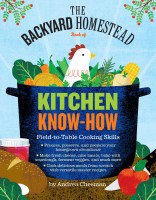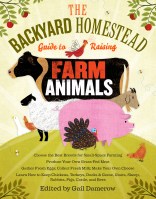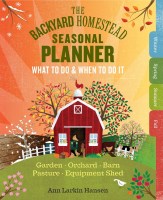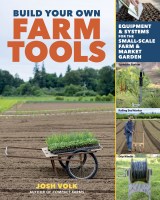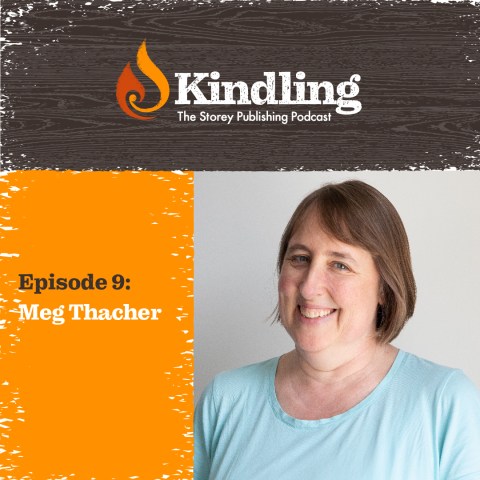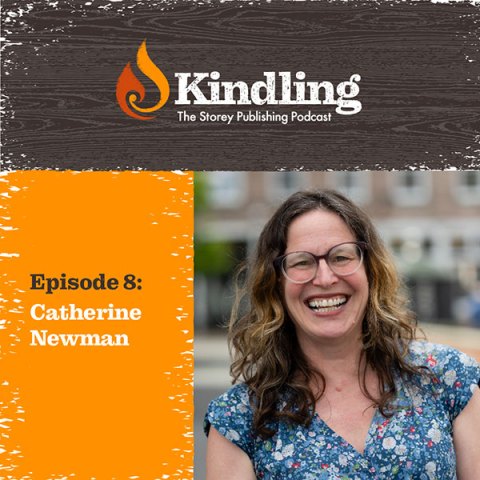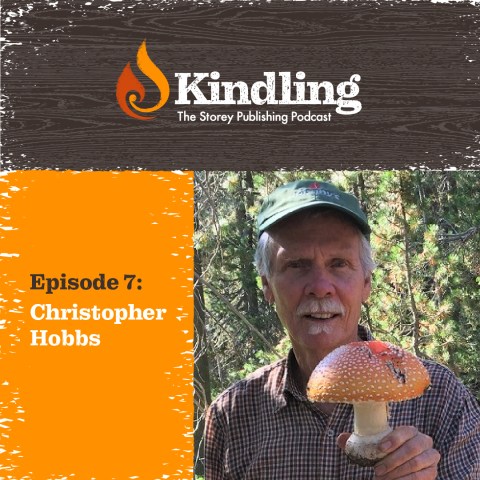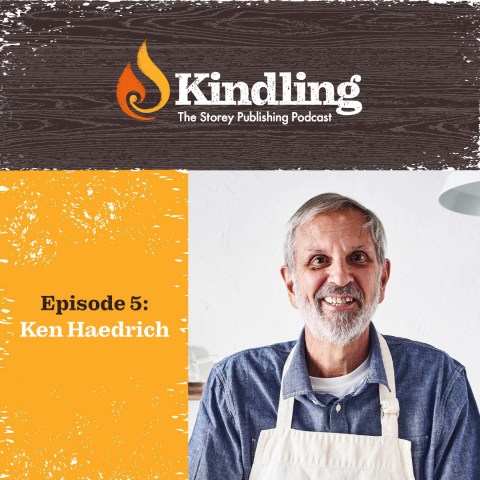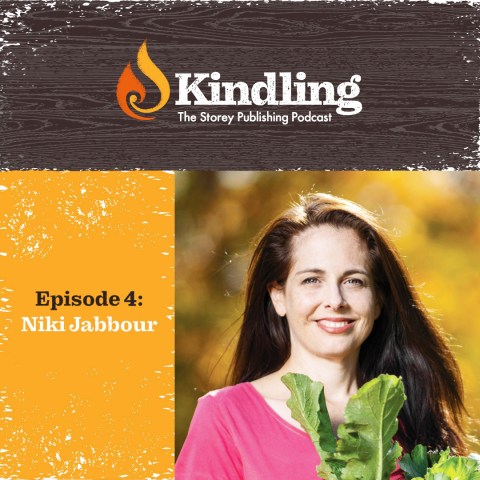Kindling Podcast Episode 2: Carleen Madigan
Tune in as Storey art director Carolyn Eckert speaks with Storey acquiring editor Carleen Madigan about her own book, The Backyard Homestead.
In this episode, Storey’s own acquiring editor, Carleen Madigan, talks about the renewed interest in The Backyard Homestead during the pandemic and the comfort she gets from gardening and tending to her own homestead.
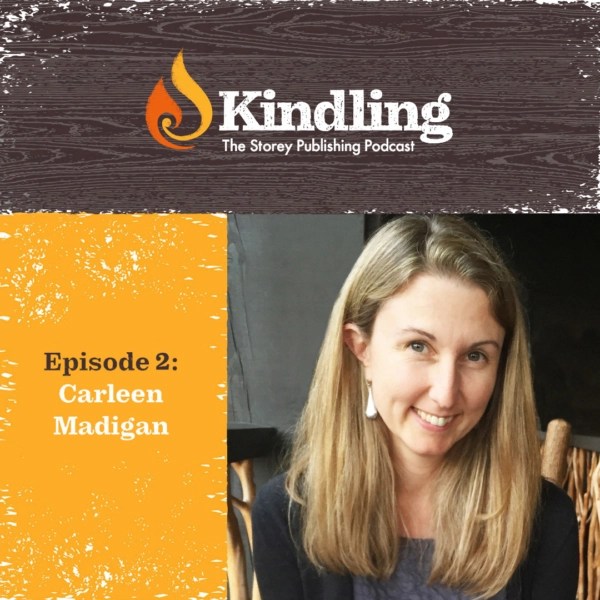
This episode of Kindling: The Storey Publishing Podcast can also be found on podcast platforms, including Spotify and iTunes. If you enjoyed this episode, please be sure to leave us a rating and review.
Full Podcast Transcript
Deborah Balmuth:
This is Kindling, the Storey Publishing podcast, where we explore the spark that ignites a deep-rooted passion for sustainable living. I’m Deborah Balmuth, Storey’s publisher. From growing organic food and making herbal remedies, to fermenting, weaving, and raising chickens, the authors we’ll meet will empower you with the skills and savvy they’ve gleaned from years of hands-on experience. In each episode of Kindling, you’ll learn what fuels these authors’ excitement and what they love most about creating books that share their expertise and enthusiasm with the world.
Homesteading is all about creating and promoting a self-sufficient lifestyle. And the woman we’re about to meet says you can grow a sustainable harvest of grains and vegetables, raise animals and keep your own honey bees on just, get this, a quarter acre of land. Carleen Madigan is editor of The Backyard Homestead. Storey’s art director, Carolyn Eckhart, recently spoke with Carleen about growing and raising your own food and enjoying your backyard bounty all winter long.
Carolyn Eckhart:
Welcome, Carleen. Hey, it’s a pleasure and really fun to be with you today.
Carleen Madigan:
Well, thanks, Carolyn.
Carolyn Eckhart:
I would love to talk about your book, The Backyard Homestead, and what you do as an editor at Storey. But first, we all need to know how many and what types of animals do you have in and outside your house right now?
Carleen Madigan:
That’s a good question. Makes it sound like we live in a barn, which we kind of do. No, we don’t keep livestock in the house for one thing. Not usually. Although I will say that before I moved up here, there was one, I don’t know, late winter, early spring when Brett, who is my husband, one of his cows gave birth early. And so, he brought the calf into the house to stay warm by the woodstove. So that’s the only, I think, exception to the no livestock in the house rule.
Carolyn Eckhart:
Whenever necessary.
Carleen Madigan:
Whenever necessary. Needs must, as the Brits say. Yeah, we have two Mexican rescue dogs named Rex and Blanco and a cat named Wendell, who’s named after Wendell Berry. I did not name him. But he loves to kill birds, which is unfortunate, and rodents, which is great. We currently have, I think, just three Scottish Highland cattle and a horse named Dolly, and we have two pigs. Oh, what else? We have six laying hens. Actually, I just realized this morning that one of them is a rooster. And yeah, that’s what we have right now. It’s good. We’re very happy right now actually have a freezer full of our own meat. All this talk about the meat processing plants closing down because of COVID, and it feels like a real luxury to be able to just go to the freezer and pull out our own meat for dinner. So we’re pretty lucky that way.
Carolyn Eckhart:
I think you just gave the perfect description of why you should have a backyard homestead right there. So we should just launch right in. And I would like to talk about the book for a little bit. In the introduction of The Backyard Homestead, you wrote about your parents’ lovely garden in Idaho, “with the pink raspberries that scrambled along the back fence. They were sun-warmed and sweet. And whenever I snatched a fistful of right berries and hid for my sister in the evergreens along the back property line, I felt that I had the makings of my own kingdom or fort of self-sufficiency.” What you wrote there just really brings the reader immediately into the romance of the home garden. I want to be there right now. How do you think this garden influenced your life and your career?
Carleen Madigan:
I’m not sure it was the garden in particular. I think it was just being around parents who were such doers. My mom was always really big on people being able to take care of themselves. And that’s really how she raised us, as you don’t know if something had happened to me tomorrow and you’ll have to take care of yourself, you’ll have to take care of each other, so this is what you need to know how to do. So I was cooking dinner, helping to cook dinner anyway, at a fairly young age and just learned to bake bread when I was in, I don’t know, a freshman in high school and learned to quilt when I was in high school, and just did all of these things. So I think it’s just the way.
And then my dad was one of these guys who just knew how to fix anything. So we never bought anything new when I was little, which I think was actually kind of an annoyance to my mom, but he knew how to fix stuff. He’d come home with something. And even when I was older, it was his favorite thing to go to the thrift store and find something that somebody had kind of tossed aside because it didn’t work and there was one piece missing and he could fix it. I think it was just kind of growing up around that culture of figuring it out and learning how to make do with what you have, and that’s how I live today.
Carolyn Eckhart:
Okay. Let’s go back into the book. I saw a story video you made a while ago where you say that the book Plenty inspired the idea for The Backyard Homestead. What was it about that book that made the idea for your book click?
Carleen Madigan:
That book, Plenty, just stuck in my head because it was essentially the story of these two Canadian writers who decided to spend a whole year eating only food that came from, I think, within a hundred miles of where they were living. So they were living in Vancouver, and they had this little kind of a shack, I think, in this really remote, rural area that they would go to for the summer and just forage and can things. And they would barter with some kind of old coot who was living in the woods and canning salmon. And so, they’d trade him like preserves for salmon or something. And unfortunately, they started their local living experiment, I think in February or March, when there was basically nothing but potatoes they could get their hands on. So they said they both lost a lot of weight and ate a lot of potatoes. But I just remember thinking what a cool concept that was, the idea of trying to source your food locally and get as much from the land as you possibly can.
It’s funny to look back on The Backyard Homestead after all this time because it’s really having a resurgence right now. There’s really a lot of interest in the book, and it’s selling very well because of the current situation we’re in with the pandemic and people feeling nervous about the food supply. But also just, I think, looking to do something that is grounding and healing, and they’re turning to gardening, which I think is great. And looking back on when the book came out right after the financial crisis in 2008, 2009, people responded to it for similar reasons.
And looking back on it in my own personal life, I’m realizing and kind of reflecting that that was a very tumultuous time for me personally. And I think that I got a lot of comfort from not necessarily just gardening, but also foraging. And I learned to spin wool. I was doing a lot of knitting. I was living in a place where I basically had just a tiny portion of my landlord’s garden out front. And it was very nice of them, but it wasn’t like a great spot to garden because I didn’t feel like it was my own space. I didn’t feel comfortable just going out there and hanging out and kind of waving to them through their kitchen window as I’m weeding. So I wanted to have it be a place of kind of solace, and it wasn’t that.
But what was a place of solace for me was kind of going for walks in the woods and looking for mushrooms and fiddleheads and things like that. So I think I was in a place of looking for that kind of comfort and really finding it in the things that are in the backyard homestead. So in some way, I really related to what people were going through at the time in a way that I didn’t realize at the time, but I kind of am thinking about now.
It’s really ironic because now it’s almost like… I hate to call it self-fulfilling prophecy or something, but now I actually really do live in a place where we have a lot of land, and we have animals, and we’re raising our own animals for meat and eggs, and I have a huge garden, and there’s actually so much that I don’t have as much time to explore all of. That’s not true because every book that I edit, I want to do what I’m editing. So I just worked on a book about medicinal mushrooms. So, of course, now everything, I just have to have medicinal mushrooms around. And now I’m working on, we’re both working on, a vinegar book with Kirsten Shockey. And so, now I’m excited to try making vinegar have lots of parsnips around, so I’m going to make parsnip vinegar. So even though I just said I’m too busy to start doing new things, I’m always doing new things. So it’s fun and exhausting.
Carolyn Eckhart:
You really bring all of these new skills that you’re working on in your books into your own life. You make tinctures for gifts, and you talk about learning about mushrooms and vinegars right now. Are there any skills you still want to learn, or do you think the skills that are most important for people to learn today?
Carleen Madigan:
Oh God, there’s a ton. I feel like I’m just constantly trying to get better at stuff that I’m really a dabbler. And it’s funny because Brett, my husband, is also a dabbler. I’ve realized he’ll get totally into something for a period of time and then kind of switch gears and get really into something else. And I think that’s actually a really good way to manage this weird addiction of having so many hobbies or things that you like to do because you can’t do them all at once. You have to kind of approach things seasonally and what’s important to you, what you enjoy, and just kind of say like, “Okay, well, I haven’t made a quilt in I don’t know how many years, and I haven’t pulled out my sewing machine in probably, I don’t know, seven or eight years,” but I just pulled it out to make masks for people during the pandemic. So it was nice to be able to call on that skill when I needed it.
I haven’t knitted in a while, but probably when fall rolls around, I’m going to start hankering for a little knitting. I really would like to get better at spoon carving. That’s something I kind of started to learn, but I have not gotten very good at it yet. And I just, I have to say gardening is one of those things that I’m always having kind of forehead smack moments where even though I’ve been gardening for more than 20 years, almost 25 years, I guess, you still realize how much you have to pay attention and how much there is to learn every single year. And that’s why, if there’s one kind of word of encouragement that I could give to people who are just starting out gardening, it’s that don’t give up in the first year, just because things got a little crazy or things didn’t turn out the way you thought they were going to turn out, just kind of treat it as an evolving process or something that you’re going to interact with over a long period of time. So yeah, there’s always something new to learn.
Carolyn Eckhart:
You’ve said that the most surprising thing to learn is what you can do in a small space. And in the book, you mentioned how you can even just slice open a bag of compost and plant right there. Is there such a thing as a homesteading hack, or is it the traditional way, the right way?
Carleen Madigan:
I feel like the essence of homesteading is hacking. It’s also why it’s so hard to write a very prescriptive book about it, because any farmer knows, you have to respond to the situation that you’re in. And you can try and learn from other people as much as possible, especially if they’re someone in your area who has kind of similar conditions. You have to learn to respond to what’s in front of you and make do with what you have, you know?
Yeah, so I think an integral part of that is learning to hack. Learning to hack, use what you’ve got. If you just have a balcony and a bag of potting mix or compost, it’s like, there’s your garden. You don’t have to have a ton of space. It’s just that you have this mentality of, I want to try and do as much as I can for myself, and I want to learn how to make do with what I have in hand and have that be part of my life experience or what my life is about because it grounds you and you get gratification from that. And it’s a sense of stability and being able to provide for yourself.
Carolyn Eckhart:
Okay. So we have to sort of wrap up here now. But in these uncertain times, do you think, besides just going out and trying to plant something this weekend, is there anything people should definitely do now that the world has changed?
Carleen Madigan:
I think that the pandemic has made people realize that they can’t be reliant on the same systems. They can’t rely on other people to always be looking out for them. So whether that is the industrial meat system, the industrial food supply in general, I think that this has kind of shown the weaknesses in those kind of large-scale systems in a way that before was very theoretical, right? Forever preppers have been talking about, “Oh, well, what if there’s a global pandemic? What would happen? The food supply chain is going to collapse.” We haven’t seen a total collapse of the food supply chain, but I think that the disruptions in the supply chain so far have shown how vulnerable they are. So I’m hoping that it will kind of shine a light on how we need to really be doing more for ourselves.
And frankly, just supporting local farmers. Local farmers are really seeing a boom from all of this because people are realizing, “Oh, I don’t have to rely on the meatpacking plant that’s a thousand miles away to get my meat. I can go down the road to my local farm and buy directly from them. That’s the most secure thing I can do.” And not to mention the fact that it’s obviously better meat. I hope that it’s going to encourage people, not just to be more self-sufficient themselves, but to see how they can make their communities more self-sufficient, and try to rely more on each other on the people that they know locally.
I hope that we all get through this pandemic and come out the other side with a renewed sense of community. And whether that’s kind of looking to your local farmer for meat and eggs and produce, or growing some yourself, but also just learning to rely on your neighbors and the people who were right around you and developing your community out of a shared sense of need instead of relying on kind of corporations and the industrial food chain. And even the government. I’m not anti-governmental, but I think that people should think and do for themselves.
Deborah Balmuth:
That was Carolyn Eckhart speaking with Carleen Madigan, editor of The Backyard Homestead. To learn more about Storey Publishing’s books and authors, visit storey.com. That’s S-T-O-R-E-Y.com. And if you have questions or comments about what you hear on Kindling, let us know. You can email us at feedback@storey.com. That’s it for this edition of Kindling. Coming to you from the Berkshire Hills of Western Massachusetts, I’m Storey’s publisher, Deborah Balmuth. Thanks for listening.
KINDLING IS PRODUCED BY SHEIR AND SHIM, LLC.
Learn More
Also available in this series: The Backyard Homestead Seasonal Planner, The Backyard Homestead Book of Building Projects, The Backyard Homestead Guide to Raising Farm Animals, and The Backyard Homestead Book of Kitchen Know-How.
